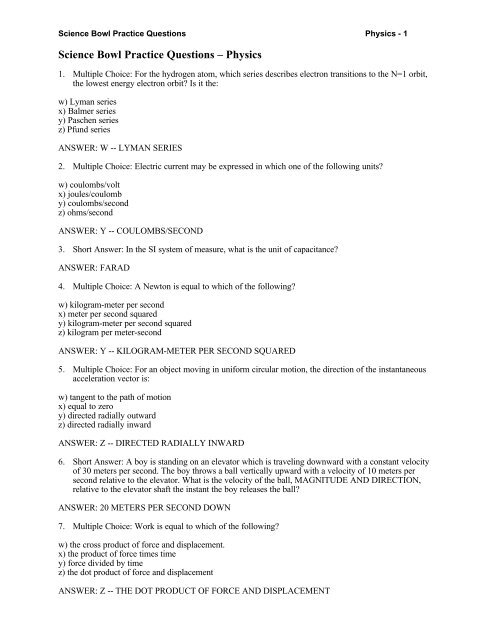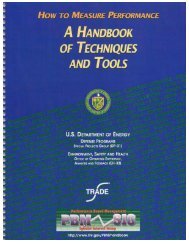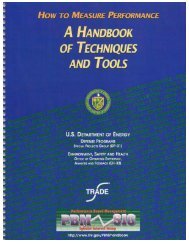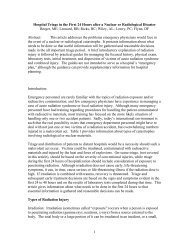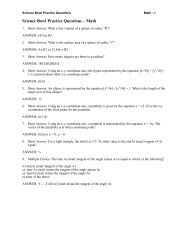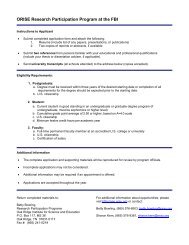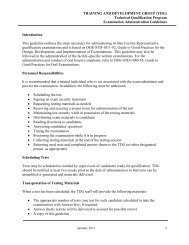Science Bowl Practice Questions â Physics
Science Bowl Practice Questions â Physics
Science Bowl Practice Questions â Physics
Create successful ePaper yourself
Turn your PDF publications into a flip-book with our unique Google optimized e-Paper software.
<strong>Science</strong> <strong>Bowl</strong> <strong>Practice</strong> <strong>Questions</strong> <strong>Physics</strong> - 1<strong>Science</strong> <strong>Bowl</strong> <strong>Practice</strong> <strong>Questions</strong> – <strong>Physics</strong>1. Multiple Choice: For the hydrogen atom, which series describes electron transitions to the N=1 orbit,the lowest energy electron orbit? Is it the:w) Lyman seriesx) Balmer seriesy) Paschen seriesz) Pfund seriesANSWER: W -- LYMAN SERIES2. Multiple Choice: Electric current may be expressed in which one of the following units?w) coulombs/voltx) joules/coulomby) coulombs/secondz) ohms/secondANSWER: Y -- COULOMBS/SECOND3. Short Answer: In the SI system of measure, what is the unit of capacitance?ANSWER: FARAD4. Multiple Choice: A Newton is equal to which of the following?w) kilogram-meter per secondx) meter per second squaredy) kilogram-meter per second squaredz) kilogram per meter-secondANSWER: Y -- KILOGRAM-METER PER SECOND SQUARED5. Multiple Choice: For an object moving in uniform circular motion, the direction of the instantaneousacceleration vector is:w) tangent to the path of motionx) equal to zeroy) directed radially outwardz) directed radially inwardANSWER: Z -- DIRECTED RADIALLY INWARD6. Short Answer: A boy is standing on an elevator which is traveling downward with a constant velocityof 30 meters per second. The boy throws a ball vertically upward with a velocity of 10 meters persecond relative to the elevator. What is the velocity of the ball, MAGNITUDE AND DIRECTION,relative to the elevator shaft the instant the boy releases the ball?ANSWER: 20 METERS PER SECOND DOWN7. Multiple Choice: Work is equal to which of the following?w) the cross product of force and displacement.x) the product of force times timey) force divided by timez) the dot product of force and displacementANSWER: Z -- THE DOT PRODUCT OF FORCE AND DISPLACEMENT
<strong>Science</strong> <strong>Bowl</strong> <strong>Practice</strong> <strong>Questions</strong> <strong>Physics</strong> - 28. Multiple Choice: The work done by a friction force is:w) always positivex) always negativey) always zeroz) either positive or negative depending upon the situation.ANSWER: X -- ALWAYS NEGATIVE9. Multiple Choice: As defined in physics, work is:w) a scalar quantityx) always a positive quantityy) a vector quantityz) always zeroANSWER: W -- A SCALAR QUANTITY10. Multiple Choice: A pendulum which is suspended from the ceiling of a railroad car is observed to hangat an angle of 10 degrees to the right of vertical. Which of the following answers could explain thisphenomena?w) The railroad car is at rest.x) The railroad car is accelerating to the left.y) The railroad car is moving with constant velocity to the right.z) The railroad car is accelerating to the right.ANSWER: X -- THE RAILROAD CAR IS ACCELERATING TO THE LEFT.11. Multiple Choice: Two forces have magnitudes of 11 newtons and 5 newtons. The magnitude of theirsum could NOT be equal to which of the following values?w) 16 newtonsx) 5 newtonsy) 9 newtonsz) 7 newtonsANSWER: X -- 5 NEWTONS12. Short Answer: A ball leaves a girl's hand with an upward velocity of 6 meters per second. What is themaximum height of the ball above the girl's hand?ANSWER: 1.8 METERS13. Short Answer: A boy throws a ball vertically upward with a velocity of 6 meters per second. How longdoes it take the ball to return to the boy's hand?ANSWER: 1.22 SECONDS (accept: 1.2 seconds)14. Short Answer: A toy train moves in a circle of 8 meters radius with a speed of 4 meters per second.What is the magnitude of the acceleration of the train?ANSWER: 2 METERS PER SECOND SQUARED15. Short Answer: A certain machine exerts a force of 200 newtons on a box whose mass is 30 kilograms.The machine moves the box a distance of 20 meters along a horizontal floor. What amount of workdoes the machine do on the box?ANSWER: 4000 JOULES
<strong>Science</strong> <strong>Bowl</strong> <strong>Practice</strong> <strong>Questions</strong> <strong>Physics</strong> - 316. Short Answer: A box is initially at rest on a horizontal, frictionless table. If a force of 10 Newtons actson the box for 3 seconds, what is the momentum of the box at the end of the 3 second interval?ANSWER: 30 NEWTON-SECONDS or 30 KILOGRAM-METER PER SECOND17. Multiple Choice: A block of metal which weighs 60 newtons in air and 40 newtons under water has adensity, in kilograms per meter cubed, of:w) 1000x) 3000y) 5000z) 7000ANSWER: X -- 300018. Short Answer: A 10 kilogram body initially moving with a velocity of 10 meters per second makes ahead-on collision with a 15 kilogram body initially at rest. The two objects stick together. What is thevelocity of the combined system just after the collision?ANSWER: 4 METERS PER SECOND19. Short Answer: A certain spring is known to obey Hooke's Law. If a force of 10 newtons stretches thespring 2 meters, how far will a 30 newton force stretch the spring?ANSWER: 6 METERS
<strong>Science</strong> <strong>Bowl</strong> <strong>Practice</strong> <strong>Questions</strong> <strong>Physics</strong> - 420. Short Answer: A helicopter is ascending vertically with a constant speed of 6 meters per secondrelative to the ground. At the instant the helicopter is 60 meters above the ground it releases a package.What is the magnitude and direction of the velocity of the package, relative to the ground, the instantthe package is released by the helicopter?ANSWER: 6 METERS/SECOND UP21. Multiple Choice: If the distance between two objects, each of mass 'M', is tripled, the force of attractionbetween the two objects is:w) 1/2 the original forcex) 1/3 the original forcey) 1/9 the original forcez) unchangedANSWER: Y -- 1/9 THE ORIGINAL FORCE22. Short Answer: A 40 kilogram girl climbs a vertical distance of 5 meters in twenty seconds at a constantvelocity. How much work has the girl done?ANSWER: 2000 JOULES or 1960 JOULES23. Short Answer: A machine performs 8 Joules of work in 2 seconds. How much power is delivered bythis machine?ANSWER: 4 WATTS24. Multiple Choice: In physics, a radian per second is a unit of:w) angular displacementx) angular velocityy) angular accelerationz) angular momentum.ANSWER: X -- ANGULAR VELOCITY25. Multiple Choice: If the resultant force acting on a body of constant mass is zero, the body's momentumis:w) increasingx) decreasingy) always zeroz) constantANSWER: Z – CONSTANT26. Short Answer: What is the name of the first American physicist to win two Nobel prizes?ANSWER: (JOHN) BARDEEN27. Multiple Choice: Which of the following scientists is responsible for the exclusion principle whichstates that two objects may NOT occupy the same space at the same time? Was it:w) Heisenbergx) Bohry) Tellerz) PauliANSWER: Z -- PAULI
<strong>Science</strong> <strong>Bowl</strong> <strong>Practice</strong> <strong>Questions</strong> <strong>Physics</strong> - 528. Short Answer: Who shared the Nobel Prize in <strong>Physics</strong> in 1909 with Guglielmo Marconi for hiscontribution to the development of wireless telegraphy?ANSWER: (CARL FERDINAND) BRAUN29. Short Answer: Who first theoretically predicted the existence of the positron, a positively chargedelectron? He received the Nobel Prize in <strong>Physics</strong> in 1933.ANSWER: (PAUL ADRIEN MAURICE) DIRAC30. Short Answer: Name the female physicist who received the Nobel Prize in 1963 for her discoveryconcerning the shell structure of the nucleus.ANSWER: (MARIA GOEPPERT) MAYER31. Short Answer: The constant potential difference across a 2 ohm resistor is 20 volts. How many watts ofpower are dissipated by this resistor?ANSWER: 200 WATTS32. Short Answer: The potential difference across a 4 ohm resistor is 20 volts. Assuming that all of theenergy dissipated by this resistor is in the form of heat, how many joules of heat are radiated in 10seconds?ANSWER: 1000 JOULES33. Multiple Choice: The force acting between two point charges can be computed using which of thefollowing laws?w) Ohm's Lawx) Ampere's Lawy) Coulomb's Lawz) Newton's Second Law.ANSWER: Y -- COULOMB'S LAW
<strong>Science</strong> <strong>Bowl</strong> <strong>Practice</strong> <strong>Questions</strong> <strong>Physics</strong> - 634. Short Answer: Five volts are applied across the plates of a parallel plate capacitor. The distance ofseparation of the plates is .02 meters. What is the magnitude of the electric field inside the capacitor?ANSWER: 250 VOLTS PER METER or 250 NEWTONS PER COULOMB35. Short Answer: Used normally, a 150-watt, 120 volt light bulb requires how many amps of current?ANSWER: 1.25 AMPS36. Short Answer: If 10 joules of energy are required to move 5 coulombs of charge between two points,the potential difference between the two points is equal to how many volts?ANSWER: 2 VOLTS37. Multiple Choice: Induced electric currents can be explained using which of the following laws?w) Gauss's Lawx) Faraday's Lawy) Ohm's Lawz) Ampere's LawANSWER: X -- FARADAY'S LAW38. Multiple Choice: For a negative point charge, the electric field vectors:w) circle the chargex) point radially in toward the chargey) point radially away from the chargez) cross at infinityANSWER: X -- POINT RADIALLY IN TOWARD THE CHARGE39. Multiple Choice: For an infinite sheet of positive charge, the electric field lines:w) run parallel to the sheet of chargex) are perpendicular to the sheet of charge and point in toward the sheety) are perpendicular to the sheet of charge and point away from the sheetz) fall off as one over r squaredANSWER: Y -- ARE PERPENDICULAR TO THE SHEET OF CHARGE AND POINT AWAY
<strong>Science</strong> <strong>Bowl</strong> <strong>Practice</strong> <strong>Questions</strong> <strong>Physics</strong> - 740. Multiple Choice: Five coulombs of charge are placed on a thin-walled conducting shell. Once thecharge has come to rest, the electric potential inside the hollow conducting shell is found to be:w) zerox) uniform inside the sphere and equal to the electric potential on the surface of the spherey) smaller than the electric potential outside the spherez) varying as one over r squared.ANSWER: X -- UNIFORM INSIDE THE SPHERE AND EQUAL TO THE ELECTRIC OTENT41. Short Answer: A two farad and a four farad capacitor are connected in series. What single capacitanceis "equivalent" to this combination?ANSWER: 4/3 FARADS42. Multiple Choice: Three capacitors with different capacitances are connected in series. Which of thefollowing statements is TRUE?w) All three of the capacitors have the same potential difference between their plates.x) The magnitude of the charge is the same on all of the capacitor plates.y) The capacitance of the system depends on the voltage applied across the threecapacitors.ANSWER: X -- THE MAGNITUDE OF THE CHARGE IS THE SAME ON ALL OFTHE CAPACITOR PLATES43. Multiple Choice: For a parallel-plate capacitor with plate area "A" and plate separation "d", thecapacitance is proportional to which of the following?w) A divided by d squaredx) A times dy) A divided by dz) d divided by AANSWER: Y -- A DIVIDED BY D44. Multiple Choice: A constant potential difference is applied across the plates of a parallel-platecapacitor. Neglecting any edge effects, the electric field inside the capacitor is:w) constantx) varying as one over r squaredy) decreasing as one moves from the positive to the negative plate z) zeroANSWER: W -- CONSTANT45. Short Answer: A 10 farad capacitor is used in a circuit. The voltage difference between the plates ofthe capacitor is 20 volts. What is the magnitude of the charge on each of the capacitor's plates?ANSWER: 200 COULOMBS46. Short Answer: A circuit which employs a DIRECT CURRENT source has a branch which contains acapacitor. After the circuit has reached a steady state, what is the magnitude of the current in the circuitbranch which contains the capacitor?ANSWER: THE CURRENT IS ZERO47. Short Answer: A charged particle is moving in a UNIFORM magnetic field. If the direction of motionof the charged particle is parallel to the magnetic field, describe the shape of the charged particle's path.ANSWER: STRAIGHT LINE
<strong>Science</strong> <strong>Bowl</strong> <strong>Practice</strong> <strong>Questions</strong> <strong>Physics</strong> - 848. Multiple Choice: An infinitely long wire carries a current of three amps. The magnetic field outside thewire:w) points radially away from the wirex) points radially inwardy) circles the wirez) is zero.ANSWER: Y -- CIRCLES THE WIRE49. Multiple Choice: A copper rod which is 1 centimeter in diameter carries a current of 5 amps. Thecurrent is distributed uniformly throughout the rod. The magnetic field half way between the axis of therod and its outside edge is:w) zero.x) pointing radially outwardy) pointing radially inwardz) circles the axis of the rodANSWER: Z -- CIRCLES THE AXIS OF THE ROD50. Multiple Choice: Iron is what type of magnetic material? Is it:w) diamagneticx) paramagneticy) ferromagneticz) non-magneticANSWER: Y – FERROMAGNETIC
<strong>Science</strong> <strong>Bowl</strong> <strong>Practice</strong> <strong>Questions</strong> <strong>Physics</strong> - 951. Short Answer: The focal length of a concave mirror is 2 meters. An object is positioned 8 meters infront of the mirror. Where is the image of this object formed?ANSWER: 8/3 METER or 2.66 METERS IN FRONT OF THE MIRROR52. Short Answer: A converging thin lens has a focal length of 27 centimeters. An object is placed 9centimeters from the lens. Where is the image of this object formed?ANSWER: -13.5 CENTIMETERS or 13.5 CENTIMETERS ON THE OBJECT SIDEOF THE LENS53. Short Answer: In Bohr's theory of the atom, what force was responsible for holding the electrons intheir orbit?ANSWER: COULOMB FORCE or THE FORCE OF ATTRACTION BETWEEN THE PROTON(NUCLEUS) AND THE ELECTRON54. Short Answer: Davisson and Germer scattered electrons from a crystal of nickel. The scatteredelectrons formed a strong diffraction pattern. What important conclusion was drawn from thisexperiment?ANSWER: ELECTRONS ACTED LIKE WAVES55. Short Answer: The speed at which a wave propagates down a string is 300 meters per second. If thefrequency of this wave is 150 Hertz, what is the wavelength of this wave?ANSWER: 2 METERS56. Multiple Choice: A standing wave is formed on a tightly stretched string. The distance between a nodeand an antinode is:w) 1/8 wavelengthx) 1/4 wavelengthy) 1/2 wavelengthz) 1 wavelengthANSWER: X -- 1/4 WAVELENGTH57. Multiple Choice: When a physical property such as charge exists in discrete "packets" rather than incontinuous amounts, the property is said to be:w) discontinuousx) abrupty) quantizedz) noncontinuousANSWER: Y – QUANTIZED58. Short Answer: Assume a ray of light is incident on a smooth reflecting surface at an angle of incidenceof 15 degrees to the normal. What is the angle between the incident ray and the reflected ray?ANSWER: 30 DEGREES59. Short Answer: The focal length of a concave spherical mirror is equal to 1 meter. What is the radius ofcurvature of this mirror?ANSWER: 2 METERS60. Short Answer: A virtual image can be formed by one or more of the following single mirrors? Identifythem.
<strong>Science</strong> <strong>Bowl</strong> <strong>Practice</strong> <strong>Questions</strong> <strong>Physics</strong> - 10w) plane mirrorx) concave spherical mirrory) convex spherical mirrorz) all of the aboveANSWER: Z -- ALL OF THE ABOVE (accept: A, B and C)61. Short Answer: A quarter of a wavelength is equal to how many degrees of phase?ANSWER: 90 DEGREES62. Multiple Choice: An organ pipe which is open at both ends resonates at its fundamental frequency.Neglecting any end effects, what wavelength is formed by this pipe in this mode of vibration if the pipeis 2 meters long?w) 2 metersx) 4 metersy) 6 metersz) 8 meters.ANSWER: X -- 4 METERS63. Multiple Choice: Whose principle or law states that each point on a wavefront may be considered anew wave source? Is it:w) Snell's Lawx) Huygen's Principley) Young's Lawz) Hertz's Law.ANSWER: X -- HUYGEN'S PRINCIPLE64. Short Answer: The frequency of a wave is 50 Hertz and its wavelength is 25 meters. What is thevelocity of this wave?ANSWER: 1250 METERS/SECOND65. Multiple Choice: The wave nature of light is demonstrated by which of the following?w) the photoelectric effectx) colory) the speed of lightz) diffractionANSWER: Z -- DIFFRACTION66. Multiple Choice: The collision between a photon and a free electron was first explained by which ofthe following scientists?w) Einsteinx) Heisenbergy) Comptonz) BohrANSWER: Y – COMPTON67. Short Answer: Besides solid, liquid, and gas, what is the fourth form of matter?ANSWER: PLASMA
<strong>Science</strong> <strong>Bowl</strong> <strong>Practice</strong> <strong>Questions</strong> <strong>Physics</strong> - 1168. Short Answer: What is 25,000 miles per hour on earth, and 5,300 miles per hour on the Moon?ANSWER: ESCAPE VELOCITY69. Short Answer: In Einstein's universe, what is the fourth dimension?ANSWER: TIME70. Multiple Choice: The Tesla and the Gauss are units of measure of:w) conductancex) magnetic field strengthy) magnetic fluxz) electrical currentANSWER: X -- MAGNETIC FIELD STRENGTH71. Short Answer: Shockley, Brattain and Bardeen won a Nobel prize for what small invention?ANSWER: TRANSISTOR72. Short Answer: What mechanical and electronic device has a name derived from a Czechoslovakianword meaning "work; compulsory service"?ANSWER: ROBOT73. Short Answer: What is the name of the temperature and pressure conditions at which water can be inthe solid, liquid and gas phases simultaneously?ANSWER: TRIPLE POINT74. Multiple Choice: Which of the following colors of visible light has the longest wavelength? Is it:w) violetx) greeny) yellowz) redANSWER: Z – RED75. Multiple Choice: A 10 kilogram mass rests on a horizontal frictionless surface. A horizontal force of 5Newtons is applied to the mass. After the force has been applied for 1 second, the velocity of the massis:w) 0 meters per secondx) 0.5 meters per secondy) 5 meters per secondz) 50 meters per secondANSWER: X -- 0.5 METERS PER SECOND76. Multiple Choice: A worker lifts a 10 kilogram block a vertical height of 2 meters. The work he does onthe block is:w) 5 Joulesx) 20 Joulesy) 49 Joulesz) 200 JoulesANSWER: Z -- 200 JOULES
<strong>Science</strong> <strong>Bowl</strong> <strong>Practice</strong> <strong>Questions</strong> <strong>Physics</strong> - 1277. Multiple Choice: An impulse of 10 kilogram-meter per second acting on an object whose mass is 5kilogram will cause a change in the objects velocity of:w) 0.5 meters per secondx) 2 meters per secondy) 10 meters per secondz) 50 meters per secondANSWER: X -- 2 METERS PER SECOND
<strong>Science</strong> <strong>Bowl</strong> <strong>Practice</strong> <strong>Questions</strong> <strong>Physics</strong> - 1378. Multiple Choice: The time needed for a net force of 10 newtons to change the velocity of a 5 kilogramsmass by 3 meters/second is:w) 1.5 secondsx) 6 secondsy) 16.7 secondsz) 150 secondsANSWER: W -- 1.5 SECONDS79. Multiple Choice: The value of G, the universal gravitational constant, was measured experimentallyby:w) Newtonx) Cavendishy) Copernicusz) KeplerANSWER: X -- CAVENDISH80. Multiple Choice: Two steel balls are at a distance S from one another. As the mass of ONE of the ballsis doubled, the gravitational force of attraction between them is:w) quarteredx) halvedy) doubledz) quadrupledANSWER: Y -- DOUBLED81. Multiple Choice: If the distance between the earth and moon were halved, the force of the attractionbetween them would be:w) one fourth as greatx) one half as greaty) twice as greatz) four times as greatANSWER: Z -- FOUR TIMES AS GREAT82. Multiple Choice: As a 10 kilogram mass on the end of a spring passes through its equilibrium position,the kinetic energy of the mass is 20 joules. The speed of the mass is:w) 2.0 meters per secondx) 4.0 meters per secondy) 5.0 meters per secondz) 6.3 meters per secondANSWER: W -- 2.0 METERS PER SECOND83. Multiple Choice: As a longitudinal wave moves through a medium, the particles of the medium:w) vibrate in a path parallel to the path of the wavex) vibrate in a path perpendicular to the path of the wavey) follow the wave along its entire pathz) do not moveANSWER: W -- VIBRATE IN A PATH PARALLEL TO THE PATH OF THE WAVE84. Multiple Choice: As a pendulum is raised to higher altitudes, its period:
<strong>Science</strong> <strong>Bowl</strong> <strong>Practice</strong> <strong>Questions</strong> <strong>Physics</strong> - 14w) increasesx) decreasesy) remains the samez) decreases, then remains the sameANSWER: W -- INCREASES85. Multiple Choice: Two vibrating particles that are "out of phase" differ in the phase of their vibrationby:w) 1/4 cyclex) 1/2 cycley) 3/4 cyclez) 1 cycleANSWER: X -- 1/2 CYCLE86. Multiple Choice: The SI unit of pressure is the:w) Torrx) dyne per centimeter squaredy) atmospherez) pascalANSWER: Z – PASCAL87. Multiple Choice: An electroscope charged WITHOUT contacting a charged body is charged by:w) inductionx) conductiony) convectionz) insulationANSWER: W -- INDUCTION88. Multiple Choice: The potential drop between the terminals of a battery is equal to the battery's EMFwhen:w) no current is drawn from the batteryx) a very large current is drawn from the batteryy) the internal resistance of the battery is very largez) the resistance in the external circuit is smallANSWER: W -- NO CURRENT IS DRAWN FROM THE BATTERY89. Multiple Choice: To convert a galvanometer to a voltmeter, you should add a:w) high resistance in seriesx) high resistance in parallely) low resistance in seriesz) low resistance in parallelANSWER: W -- HIGH RESISTANCE IN SERIES90. Multiple Choice: The greatest induced EMF will occur in a straight wire moving at constant speedthrough a uniform magnetic field when the angle between the direction of the wire's motion and thedirection of the magnetic field isw) 0 degreesx) 30 degrees
<strong>Science</strong> <strong>Bowl</strong> <strong>Practice</strong> <strong>Questions</strong> <strong>Physics</strong> - 15y) 60 degreesz) 90 degreesANSWER: Z -- 90 DEGREES91. Multiple Choice: A 10 volt battery connected to a capacitor delivers a charge of 0.5 coulombs. Thecapacitance of the capacitor is:w) 2 x 10-2 faradsx) 5 x 10-2 faradsy) 2 faradsz) 5 faradsANSWER: X -- 5 x 10-2 FARADS92. Multiple Choice: Two light rays will interfere constructively with maximum amplitude if the pathdifference between them is:w) one wavelengthx) one-half wavelengthy) one-quarter wavelengthz) one-eighth wavelengthANSWER: W -- ONE WAVELENGTH93. Multiple Choice: Light is normally incident on a thin soap film and is reflected. If the wavelength ofthis light is "L" and the index of refraction of the soap film is "N", complete destructive interferencewill occur for a film thickness of:w) L / 8Nx) L / 4Ny) L / 2Nz) 3L / 4NANSWER: Y -- L / 2N94. Multiple Choice: The Michelson interferometer was designed to study the nature of:w) water wavesx) sound wavesy) an "ether"z) sunlightANSWER: Y -- AN "ETHER"95. Multiple Choice: The Millikan experiment showed that electric charge was:w) negativex) quantizedy) positivez) unmeasurableANSWER: X -- QUANTIZED96. Multiple Choice: When a metal becomes a superconductor, there is a tremendous decrease in its:w) total volumex) electrical resistancey) lengthz) density
<strong>Science</strong> <strong>Bowl</strong> <strong>Practice</strong> <strong>Questions</strong> <strong>Physics</strong> - 16ANSWER: X -- ELECTRICAL RESISTANCE97. Multiple Choice: An x-ray photon collides with a free electron, and the photon is scattered. During thiscollision there is conservation of:w) momentum but not energyx) neither momentum nor energyy) energy but not momentumz) both momentum and energyANSWER: Z -- BOTH MOMENTUM AND ENERGY98. Multiple Choice: In the sun, helium is produced from hydrogen by:w) radioactive decayx) disintegrationy) fissionz) fusionANSWER: Z – FUSION99. Multiple Choice: The half-life of an isotope of an element is 5 days. The mass of a 10 gram sample ofthis isotope remaining after 20 days is:w) 0.312 gramsx) 0.625 gramsy) 1.25 gramsz) 2.50 gramsANSWER: X -- 0.625 GRAMS100. Multiple Choice: The idea that electrons revolved in orbits around the nucleus of an atom withoutradiating energy away from the atom was postulated by:w) Thompsonx) Bohry) Rutherfordz) EinsteinANSWER: X -- BOHR


